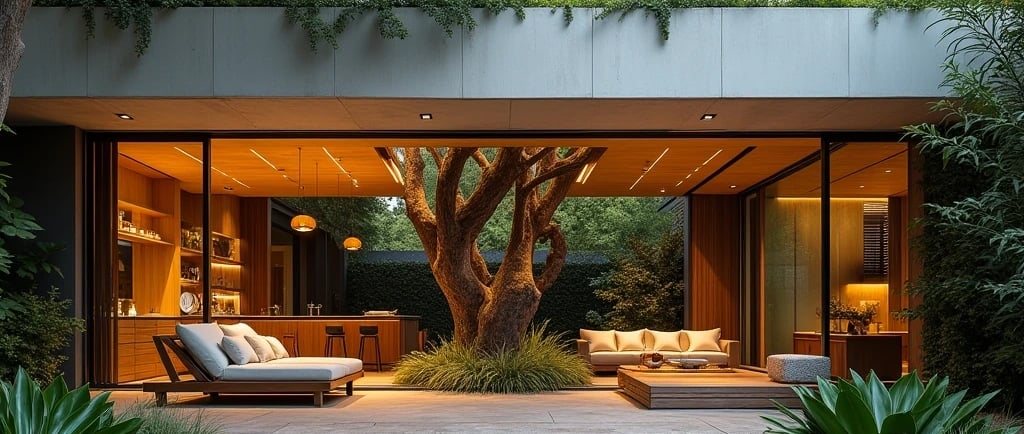Bringing the Outdoors In: How Nature Can Transform Our Homes
Take a moment right now to look outside your window. What would it mean to bring just a little bit of that green inside? I’ve been diving into the world of biophilic design—the practice of connecting people and nature through architecture—and how it’s starting to reshape premium residential projects here in Brisbane and beyond. This article isn’t a how-to guide (yet!)—it’s part of my ongoing learning journey as I build Wigwam Architects and explore ways to design healthier, more grounded spaces. If you're curious about how integrating natural elements like light, plants, water, and even air flow can genuinely improve the way we live at home, I’d love for you to read it. Let’s learn and grow together 🌱
5/28/20253 min read


Take a moment right now to look outside your window and think about how bringing some of that green inside could make your day.
Whether it’s a glimpse of a garden, the leafy canopy of a street tree, or a balcony overflowing with pots, these everyday connections to nature have the power to shift how we feel. In Brisbane, where sunlight and subtropical greenery are part of our environment, designing with nature isn’t just a nice-to-have—it’s a deeply human way to shape spaces that make us feel well and whole.
Why Nature Matters in Architecture
Many cultures have long understood the importance of living close to nature. From traditional Queenslander homes with their deep verandahs and open breezeways, to Japanese homes that frame views of courtyards and gardens, architecture has often mirrored our need to stay connected to the natural world.
Now, neuroscience and environmental psychology are catching up. Studies show that proximity to nature—whether through views, ventilation, textures, or materials—can lower stress, reduce heart rate and blood pressure, and improve focus and sleep. That’s a powerful argument for integrating greenery not just as a backdrop, but as a fundamental part of how we design homes.
What Is Biophilic Design?
Biophilic design is about creating buildings that connect people with nature—not only visually, but through all the senses. The term comes from biophilia, a concept popularised by biologist Edward O. Wilson, which suggests that humans have an innate affinity for the natural world. Biophilic design translates this idea into architecture.
This might mean introducing natural light, using materials like timber or stone, or designing for airflow that mimics outdoor conditions. It could also involve shapes and patterns that reflect nature—like undulating forms or dappled shadows. Importantly, biophilic design goes beyond adding greenery to a space. It’s about creating places that feel alive, where the boundaries between indoors and outdoors are blurred in thoughtful, responsive ways.
There are generally three types of biophilic design strategies:
Direct experience of nature, such as indoor plants, views of trees, breezes, water features, or natural light.
Indirect experience, like natural materials, colours, or biomorphic forms.
Spatial conditions that mimic natural settings—refuge, prospect, transition, or mystery.
When well-considered, these approaches can lead to spaces that support mental clarity, emotional resilience, and physical wellbeing.
Designing Homes That Breathe
At Wigwam Architects, we’re curious about how these ideas translate into real homes. How can we make a kitchen feel more connected to the garden? Where can we create nooks that feel sheltered but still open to light and air? How do we allow our buildings to evolve with the seasons?
The answers are often simple but require intention. A window placed to frame a tree. A courtyard that draws light into the centre of the house. A layout that allows for natural cross-ventilation. These gestures don’t just improve comfort and sustainability—they connect us to something bigger.
It Takes a Team
Designing homes that embrace nature isn’t something architects do alone. To get it right, we work closely with consultants—structural engineers, landscape architects, and other specialists—who help integrate greenery and natural elements safely and sustainably into the building fabric.
Sometimes that means reinforcing a slab for a courtyard tree, adjusting drainage to support planter boxes, or aligning built structure with a landscape plan that will grow and thrive over decades. These conversations happen early in the design process and ensure that nature becomes part of the home’s architecture—not an afterthought.
Beyond Greenwashing
Biophilic design isn’t about ticking boxes or adding a pot plant in the corner. It’s a philosophy that asks us to design for human experience, rooted in place and time. That could mean materials that age gracefully, openings that welcome shifting light, or rooms that invite the breeze on a summer afternoon. These choices are often invisible to the casual observer—but deeply felt by those who live there.
Living Architecture
In the end, a home that brings nature in isn’t just “eco-friendly.” It’s more joyful, more grounded, and more adaptable. Gardens grow, weather changes, and people’s lives evolve. When architecture embraces those rhythms, it becomes something more than shelter—it becomes a living framework for a good life.
At Wigwam Architects, we think of nature not as an add-on, but as a collaborator in design. And as we explore these ideas in our work, we look forward to sharing what we learn—so we can grow alongside our community.
References:
Terrapin Bright Green. “14 Patterns of Biophilic Design: Improving Health and Well-Being in the Built Environment.”
Kellert, Stephen R., et al. Biophilic Design: The Theory, Science and Practice of Bringing Buildings to Life.
Ulrich, R.S. (1984). “View through a window may influence recovery from surgery.” Science, 224(4647), 420–421.
Get in touch
© Wigwam Architects
Wigwam Architects Pty Ltd ATF Wigwam Trust ABN 77 283 233 729
Wigwam Architects respectfully acknowledges the Quandamooka people as the Traditional Custodians of the land on which we live and work. We honor their enduring connection to Country, community, and culture and recognize their deep knowledge and care for this land and its waterways. We pay our respects to Elders past, present, and emerging and extend that respect to all Aboriginal and Torres Strait Islander peoples today.


